Sabena
This articleneeds additional citations forverification.(February 2009) |
| |||||||
| Founded | 23 May 1923 | ||||||
|---|---|---|---|---|---|---|---|
| Ceased operations | 7 November 2001 (operations transferred toDelta Air Transport,which later becameSN Brussels Airlines) | ||||||
| Hubs | Brussels Airport | ||||||
| Frequent-flyer program | Qualiflyer | ||||||
| Subsidiaries |
| ||||||
| Headquarters | Zaventem,Belgium | ||||||
| Key people |
| ||||||
TheSocieté anonyme belge d'Exploitation de la Navigation aérienne(French;lit. 'Belgian Corporation for the Exploitation of Aerial Navigation'), better known by the acronymSabenaorSABENA,was the national airline of Belgium from 1923 to 2001, with its base atBrussels Airport.After itsbankruptcyin 2001,SN Brussels Airlineswas formed through a takeover of former subsidiaryDelta Air Transportand took over part of Sabena's assets in February 2002. SN Brussels Airlines merged withVirgin Expressin 2007 to formBrussels Airlines.The airline's corporate headquarters were located in the Sabena House on the grounds ofBrussels AirportinZaventem.[1]
History
[edit]1923–1939: Beginnings
[edit]Sabena began operations on 23 May 1923 as the national carrier of Belgium.[2]The airline was created by theBelgian Governmentwith help of the Devriendt Family after its predecessorSNETA(Syndicat national pour l'étude des transports aériens,National Syndicate for the Study of Aerial Transports) - formed in 1919 to pioneer commercial aviation in Belgium - ceased operations. Sabena operated its first commercial flight from HarenBrusselstoLondon(England) on 1 July 1923, viaOstend.Services toRotterdam(Netherlands) andStrasbourg(France) were launched on 1 April 1924. The Strasbourg service was extended toBasel(Switzerland) on 10 June 1924.Amsterdam(Netherlands) was added on 1 September 1924, andHamburg(Germany) followed on 1 May 1929 viaAntwerp,DüsseldorfandEssen.
Belgian Congo
[edit]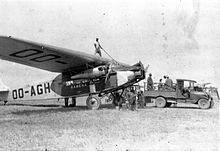
When Sabena was created, the airline was partly funded by Belgians in theBelgian Congocolonywho had lost their air service, an experimental passenger and cargo company (LARA) betweenLéopoldville,Lisala,andStanleyvillea year earlier. They expected the new Belgian national airline to fill this gap. On 12 February 1925, Sabena pioneered a long haul across Africa toLeopoldville,capital of the Belgian Congo. Throughout its history, Sabena had a long tradition of service to African destinations and for a long time, these were the only profitable routes served by the airline.
Sabena used land planes for its Congo operations and a program of aerodrome construction was initiated in the Congo. This was finished in 1926 and Sabena immediately began flights within the Belgian colony, the main route beingBoma-Léopoldville-Élisabethville,a 2,288 km (1,422 mi) route over densejungle.First, flights were operated withDe Havilland DH.50s,although these were quickly replaced by the largerHandley Page W.8fwhich had three engines and offered ten seats.
By 1931 Sabena's fleet, including the aircraft used on the Congo network, totalled 43 aircraft. Its mainstay type was theFokker F.VIIB with a lesser number of smaller Fokker VIIA and 14 Handley-Page types. It also flew BritishWestland Wessexaircraft.
Sabena occasionally flew to tropical Africa, Belgium's Congo colony, but mostly these aircraft were shipped out. There was no direct flight yet between Belgium and the colony. As the 1930s progressed, Sabena cooperated withAir FranceandDeutsche Luft Hansa,which also had interests in routes to destinations across Africa.
Sabena's first long-haul flight to the Congo occurred on 12 February 1935 and took five and a half days, for which Sabena used a Fokker F-VII/3m aircraft. The following year, Sabena purchased theSavoia-Marchetti SM.73airliner. With a speed of 300 km/h (200 mph), it reduced the journey time to only four days, and the Sabena service ran on alternate weeks to anAir Afriqueservice.[citation needed]
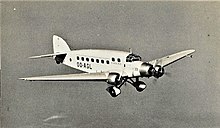
Expansion in Europe
[edit]In Europe, Sabena opened services toCopenhagenandMalmöin 1931 and a route to Berlin was initiated in 1932. The mainstay pre-war airliner that Sabena used in Europe was the successfulJunkers Ju 52/3m airliner. The airline's pre-war routes covered almost 6,000 km within Europe. While the BrusselsHaren Airportwas Sabena's main base, the company also operated services from other Belgian airports and had a domestic network that was mainly used by businessmen who wanted to be in their coastal villas for the weekend.
In 1938, the airline purchased the newSavoia-Marchetti SM.83,a development of the S.M. 73 with a speed of 435 km/h (270 mph), although it flew services at a cruising speed of about 400 km/h (250 mph).
1939–1946: Wartime
[edit]At the outbreak ofWorld War IIin 1939, Sabena's fleet totalled 18 aircraft. Its mainstay fleet type was theSavoia-Marchetti SM.73airliner (it had 11 of the type) and the Junkers Ju 52/3m airliner (it had five). Sabena also had just taken delivery of twoDouglas DC-3s.
During the war, the airline maintained its Belgian Congo routes, but all European services ceased.
1946–1960: Transatlantic expansion
[edit]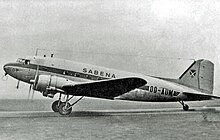
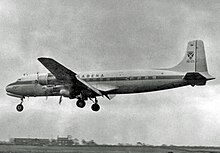
After the war, in 1946 Sabena resumed operating a network of intra-European scheduled services. The fleet initially consisted mainly of Douglas DC-3s. There were thousands of surplusDouglas C-47 Skytrains(the military variant of the DC-3) available to help airlines restart operations after the war. The airline now flew under the name ofSABENA - Belgian World Airlines.
Sabena started its first transatlantic route to New York City on 4 June 1946, initially using unpressurisedDouglas DC-4airliners which were augmented and later replaced byDouglas DC-6Bs. The DC-4s also restarted the airline's traditional route to the Belgian Congo. Sabena was the first airline to introduce transatlantic schedules from the north of England, when one of its DC-6Bs inaugurated the Brussels-Manchester-New Yorkroute on 28 October 1953.
TheConvair 240was introduced in 1949 to partially replace the DC-3s that until then had flown most European services. As of 1956, improvedConvair 440 "Metropolitan"twins began replacing the Convair 240 twins and were used successfully well into the 1960s between European regional destinations.
In 1957, the long-rangeDouglas DC-7C was introduced for long-haul routes but this plane would begin to be supplanted after only three years by thejet age.It remained in service on the transatlantic route until 1962.
On 3 June 1954, a Soviet Air ForceMikoyan-Gurevich MiG-15(NATO reporting name"Fagot" ) attacked a Sabena-operatedDouglas DC-3on a cargo flight from the United Kingdom toYugoslavia,killing the radio operator and wounding both the captain and engineer. Co-pilot Douglas Wilson managed to land in Austria but the plane suffered significant damage.[3]
For the1958 world expositionin Brussels, Sabena leased twoLockheed Super ConstellationsfromSeaboard World Airlines,using them mainly on transatlantic routes. In the same period, there were experiments with helicopter passenger service usingSikorsky S-58aircraft from Brussels to Antwerp, Rotterdam, Eindhoven and the Paris heliport atIssy-les-Moulineaux.
1960–1990: The jet age
[edit]| Year | Traffic |
|---|---|
| 1950 | 235 |
| 1955 | 579 |
| 1960 | 1,264 |
| 1965 | 1,635 |
| 1971 | 2,720 |
| 1975 | 3,796 |
| 1980 | 4,853 |
| 1989 | 6,760 |
| 1995 | 8,620 |
| 2000 | 19,379 |

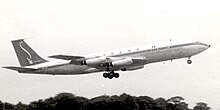
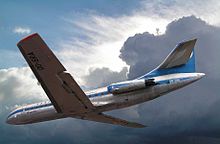


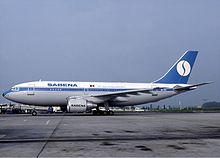
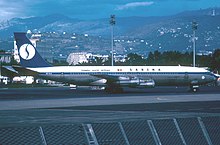
1960 saw the introduction of theBoeing 707-320intercontinental jet for trans-Atlantic flights to New York. SABENA was mainland Europe's first airline to operate a jet across the Atlantic (BOAChad been flying jet transatlantic services using thede Havilland Comet 4since 4 October 1958). One of Sabena's aircraft became the first Boeing 707 to crash while in commercial service whenFlight 548crashed while preparing to land at theBrussels Airporton 15 February 1961. The United States Figure Skating Team was aboard the aircraft, en route from New York to Prague via Brussels to compete in a figure skating championship.
SixCaravellejetliners were introduced on all medium-haul routes in Europe from February 1961, being flown on most routes alongside theConvair 440s,until the early 1970s.
The beginning of the 1960s saw a major upheaval for Sabena in theCongo.Widespread rioting against Belgian colonials in the months leading up to, and after the independence of theDemocratic Republic of the Congo,caused thousands of Belgians to flee the country. The Belgian government commandeered Sabena's entire long-haul fleet to get the refugees back to Europe. Independence also meant the end of the impressive regional network of routes that the airline had built up in the Congo since 1924. When the new republic began its own airline,Air Congo,in June 1961, Sabena held 30 per cent of that airline's shares.
The Douglas DC-6Bs remained in service with Sabena in the mid-1960s although they were no longer used on the airline's main routes. The Boeing 707s and Caravelles became the mainstay types during this decade.Boeing 727-100swere introduced on important European routes and also some African services from 1967 in a unique colour scheme; the fin markings incorporated bare-metal rudder and white engine colours. At this timeFokker F27sentered service between regional Belgian airports and European destinations such asLondon Heathrow.
TheBoeing 747-100was introduced in 1971, on transatlantic routes flying alongside the Boeing 707-320Cs. Sabena, like many other trans-Atlantic airlines, was satisfied with the Boeing 707s. For commercial reasons, it was recognised that it had to buy jumbo jets for its prestige services, notablyNew York JFKand as of the mid-seventies,Chicago O'Hare.Sabena purchased only two first-generation jumbo jets, one namedTante Agathe(which means Aunt Agathe in French and Dutch, the national languages of Belgium), and it continued to fly the 707 into the early 1980s, as the Boeing 747-100's last flight occurred in 1993.
In 1973, the Boeing 727s on the European network were replaced byBoeing 737-200s.TheMcDonnell Douglas DC-10-30entered service in 1974. In total, Sabena purchased five of these convertible (Passengers and/or freight)combi aircraftwide-body jets.
In 1984Airbus A310swere introduced on routes that had high passenger density. This aircraft type also introduced a modernisation of the 1973 Sabena livery, in which a lighter blue was used and the titles on the fuselage were in a more modern style.
In June 1986 the first of twoBoeing 747-300aircraft joined the fleet, eventually replacing the older 747-100s.
In 1989 Sabena invited Belgian fashion designerOlivier Strellito create a new range of uniforms for its cabin crews.
1990–1995: Sabena World Airlines
[edit]
A new name,Sabena World Airlines,and colours were introduced for the 1990s. The new livery had an overall white colour and the white circle tail logo in blue on the fin. A large "Sabena" title covered thefuselagein light blue and the name "Belgian World Airlines" was at times just visible, though the title was also painted on the fuselage in small, clear letters. The 1990s saw further fleet type renewal: the DC-10-30s were replaced with twin-enginedAirbus A330and the Boeing 747s with four-enginedAirbus A340.

After the liberalisation of the airline industry throughout Europe and the economic consequences of theGulf War,the Belgian government, the main shareholder of the company, realized that Sabena had little chance of surviving on its own in this very competitive market, and began searching for a suitable partner.
Sabena remained in a poor financial state, and year after year the Belgian government had to cover losses, however it was prevented from providing new funds due to EU State Aid rules. For help in business due to their financial problems, Sabena leased a couple of Boeing 747s fromAir France.Many more aircraft were leased for longer periods, but had to keep their distinctive Frenchregistration numbers.

Around 1987,SAStried to merge with the carrier, but the merger was blocked by the Belgian authorities. In 1989,British AirwaysandKLMpurchased stakes in Sabena, which were later sold back to the Belgian government. In 1993,Air Francepurchased a large minority stake in Sabena, which it sold soon after. Finally, in 1995,Swissairpurchased a 49 percent stake in Sabena and took over management.
In 1993 Sabena adopted its third and final logo, and its head office was in the Air Terminus building on Rue Cardinal Mercier inBrussels.[4]
In 1994,Paul Rusesabagina,a manager for Sabena-owned hotels in the former Belgian territory ofRwanda,sheltered over 1200 Tutsis and moderate Hutus at theHôtel des Mille CollinesofKigali,saving them from being slaughtered by theInterahamwemilitia during theRwandan genocide(this is depicted in the 2004 motion pictureHotel Rwanda).[5]
1995–2001: Swissair control
[edit]

When Swissair took over management of the airline, a few modifications were made to the aircraft's liveries, including a sticker, saying:Flying together with Swissair. In March and April 1998 twoMcDonnell-Douglas MD-11aircraft, both leased fromCityBird,joined the fleet and such long-haul destinations asNewark,MontrealandSão Paulowere (re)introduced. Also, that year saw the delivery of the last passenger version of the MD-11 from Boeing, which merged withMcDonnell Douglasa year before.
1999 saw new colours introduced to the fleet, beginning with anAirbus A340.One of the latest fleet types that Sabena introduced, right after theA321andA320was theA319which saw service in 2000. These new planes were part of a record-order of 34Airbus A320 familyaircraft, imposed on Sabena when under Swissair management.[6]
2001: Bankruptcy
[edit]
After an airline recession and the effects on the airline industry of theSeptember 11 attacksin 2001, all airlines that flew across the Atlantic suffered. Swissair had pledged to invest millions in Sabena but failed to do so, partly because the airline had financial problems itself, having filed for bankruptcy protection one month prior. Sabena filed for legal protection against its creditors on 3 October, and went into liquidation on 6 November 2001.Fred Chaffart,chairman of the board of directors of Sabena, read a declaration on this day to explain the decision.
7 November 2001 was the final day of operations for Sabena. Flight 690 (operated by anAirbus A340-311registered as OO-SCZ) fromAbidjan,Ivory Coast andCotonou,Benin, was the last Sabena flight to land in Brussels.[7]The flight had 266 passengers and eleven crew members.
A group of investors managed to take overDelta Air Transport,one of Sabena's subsidiaries, and transformed it intoSN Brussels Airlines.That airline merged withVirgin Expressin 2006 to form a new company,Brussels Airlines.
TheBelgian Parliamentformed a committee to investigate the reasons behind the bankruptcy of Sabena and the involvement of Switzerland's flag carrier. At the same time, the company's administrator investigated possible legal steps against Swissair, and its successors in interestSwiss International Air LinesandLufthansa.
In 2006, the Belgian government, a former major shareholder, filed criminal charges against the former Swissair management. The former Swissair management was condemned by the judges.[8]
On 16 January 2007 the Belgian - Flemish news programTerzakereported that during the 1990s, several members of the board were paid large sums illegally through a Sabena affiliate inBermuda.When Paul Reutlinger became the CEO of the company, he stopped the illegal payments.Terzakewent on to state that this might explain why the Belgian board members remained quiet when it became apparent Swissair was exploiting Sabena and eventually drove the company into bankruptcy.
The reasons for the bankruptcy of Sabena are numerous. One of the direct causes wasSwissairnot living up to their contractual obligations and failing to inject necessary funds into the company. This was because at the time Swissair was having its own financial problems. In the so-called "Hotel Agreement", signed on July 17, 2001, Belgian prime ministerGuy Verhofstadtmet with Swissair BossMario Corti,who agreed to inject €258 million into Sabena, but the sum was never paid. The purchase of 34 newAirbus A320 familyplanes, imposed under Swissair's management, was a burden with which Sabena could not cope.[6][9]
After the bankruptcy, a parliamentary commission in Belgium was established to investigate the demise of the airline. The Belgian politicians got a part of the blame;Rik Daems,who, at the time, was Minister of Public Enterprises and Participations, Telecommunication and Middle Classes, received the most criticism due to his lack of effort. Swissair itself went bankrupt in October 2001 and was liquidated in March 2002.[10][11]
Destinations
[edit]The flight schedule of Sabena published in March 2001 comprised 33 cities in Europe, 17 in Africa, 6 in North America, and 4 in Asia.[12]In addition to its air destinations, Sabena also had a ground shuttle service betweenValenciennes,France, andBrussels Airport.[13]
Fleet
[edit]Sabena's fleet consisted of the following aircraft at the time of the bankruptcy in November 2001:[14]
| Aircraft | In service |
Orders | Passengers | Notes | ||
|---|---|---|---|---|---|---|
| C | Y | Total | ||||
| Airbus A319-100 | 15 | 10 | — | 131 | 131 | On order but never delivered. |
| Airbus A320-200 | 6 | — | — | 156 | 156 | |
| Airbus A321-200 | 3 | — | — | 188 | 188 | |
| Airbus A330-200 | 6 | — | 54 | 187 | 241 | |
| Airbus A330-300 | 4 | — | 50 | 222 | 272 | |
| Airbus A340-200 | 2 | — | 54 | 198 | 252 | |
| Airbus A340-300 | 3 | 3 | 52 | 242 | 294 | On order but never delivered. |
| Boeing 737-300 | 6 | — | — | 126 | 126 | |
| Boeing 747-200 | 6 | — | — | 111 | 111 | |
| McDonnell Douglas MD-11 | 2 | — | 48 | 249 | 297 | Leased fromCityBird. Last passenger version delivered in 1998. |
| Total | 53 | 13 | ||||
During the time of the airline's existence, Sabena also operated these aircraft:[14][15]
Accidents and incidents
[edit]- 7 December 1934:At least two SABENA aircraft were destroyed in a hangar fire atHaren Airportas a result of a crash of a militaryFairey Foxbiplane.
Flights to or from Europe
[edit]- 11 September 1930:A SABCA F7b/3m (OO-AIN) lost control and crashed shortly after takeoff from Croydon Airport following an unexplained in-flight fire, killing both pilots.[16]
- 10 December 1935:ASavoia-Marchetti S.73(registeredOO-AGN)crashedatTatsfield,Surrey,United Kingdom, with the loss of 11 lives.
- 4 January 1937:Max Wennerdisappeared from a Savoia Marchetti S.73 (registration OO-AGP) over Belgium; the plane itself was dismantled and hauled away by the Germans shortly afterinvasion of Belgium in 1940.[17]
- 16 November 1937:AJunkers Ju 52/3m(registered OO-AUB)crashed near Ostend,Belgium, while landing, killing all 12 people on board.
- 10 October 1938:A Savoia-Marchetti S.73 (OO-AGT) broke up in mid-air over Soest, Germany en route to Berlin from Düsseldorf, killing all 20 on board.[18]
- 14 March 1939:A Junkers Ju 52/3mge (OO-AUA) crashed in a field at Sint-Stevens-Woluwe due to pilot error, killing the three crew. The aircraft was operating a cargo (mail) from London to Brussels.[19]
- 17 September 1946:ADouglas DC-3(registered OO-AUR) crashed upon takeoff fromHaren Airport,killing one crew member. The other two crew and four passengers on board the flight bound forCroydon Airportsurvived. The aircraft had lost airspeed on takeoff for unknown reasons.[20]

- 18 September 1946:27 people died when a SABENADouglas DC-4(OO-CBG) crashed 35 km short ofGander, Newfoundland,where the aircraft planned to land for a refueling stop on the flight from Brussels to New York. At the time of the accident, there was dense fog near the airport, and the pilot executed a flawed approach at too low an altitude. There were 17 survivors (16 passengers and one crew).[21]
- 2 March 1948:The 19 passengers and three crew members on a flight from Brussels to London died when aDouglas DC-3registered OO-AWH,crashedon approach toLondon Heathrow Airportin low visibility conditions.
- 18 December 1949:ADouglas DC-3(registered OO-AUQ)crashednearAulnay-sous-Bois,France, killing the four passengers and four crew on board. The aircraft had just leftLe Bourget Airportfor a flight to Brussels, when a wing separated.[22]
- 14 October 1953:AConvair CV-240(registered OO-AWQ)crashednearKelsterbach,West Germany, killing the 40 passengers and four crew aboard the flight fromFrankfurtto Brussels. Engine power was lost upon takeoff fromFrankfurt Airport,making the aircraft impossible to control. The accident remains the deadliest involving the Convair 240.[23]
- 19 December 1953:One passenger on board a flight from Brussels toZürichwas killed when the aircraft (a CV-240 registered OO-AWO) hit the ground 2.5 km short of the runway threshold ofKloten Airport.In low visibility conditions, the pilot descended below theglidepath.The other 39 passengers and three crew members survived the accident.[24]
- 3 June 1954:ADouglas DC-3(registered OO-CBY) wasattackedby aMikoyan-Gurevich MiG-15fighter aircraft nearMaribor,Yugoslavia. The aircraft, on a cargo flight fromBlackbushe AirporttoBelgrade,remained airborne, and a forced landing atGraz Airportwas carried out, during which it ran off the runway. In the incident, one out of the four people on board was killed.[25]
- 13 February 1955:The pilots ofFlight 503from Brussels to Rome lost orientation when approachingCiampino Airport,resulting in the Douglas DC-6 registered OO-SDB crashing into the slope ofMonte Terminillo,killing the 21 passengers and eight crew on board.[26]
- 15 February 1961:The crash ofFlight 548with its 73 casualties marked the worst accident in the history of SABENA. The aircraft, aBoeing 707registered OO-SJB, crashed atBrussels Airportat the end of a flight fromNew York City.[27]Among the dead were the entire American delegation to the 1961World Figure Skating Championshipsslated to be held inPrague;the competition was canceled in the aftermath.
- 13 July 1968:Flight 712,a cargo-configured 707 (registered OO-SJK) crashed upon approach toLagos Airportin Nigeria on a flight from Brussels, killing the seven occupants. It was determined that the aircraft descended too low and struck trees.[28]
- 9 May 1970:ADouglas DC-3(registered OO-AUX) was damaged beyond repair in a ground accident atAmsterdam Airport Schiphol.The pilots began to taxi the aircraft even though they had not been cleared to do so, which resulted in the right propeller hitting an obstacle on the ground, and debris destroying the airliner beyond economic repair. The aircraft had been leased from Delta Air Transport.[29]
- 8 May 1972:Flight 571from Vienna toTel Avivwith 101 people on board (a Boeing 707 registered OO-SJG) was hijacked by four members of the terrorist organizationBlack September,in order to secure the release of 315 detainees from Israeli prisons. AtBen-Gurion International Airport,two hijackers were shot and killed by the IsraeliSayeret Matkalspecial forces. One passenger died later of the wounds she had suffered in the shootout.[30]

- 15 February 1978:ABoeing 707(registered OO-SJE) undershot the runway atLos Rodeos Airport,causing the nose gear to collapse, at the end of a chartered holiday flight from Brussels with 189 passengers and seven crew on board. All passengers and crew were evacuated safely but the spilled fuel caught fire, destroying the aircraft.[31]
- 4 April 1978:ABoeing 737-200(registered OO-SDH) on a training flight suffered abird strikeduring a practice landing atCharleroi Airport.The pilot instructor attempted to get the aircraft airborne again, but failed because of insufficient remaining runway. The aircraft was damaged beyond repair.[32]
- 29 August 1998:Flight 542 from New York to Brussels with 248 passengers and 11 crew members on board, anAirbus A340-200(registered OO-SCW), suffered a broken right landing gear upon landing at Brussels Airport. The aircraft veered off the runway. There were no notable injuries in the ensuing evacuation, and the aircraft was repaired. Main gear metal fatigue was blamed for the incident.[33]
- 13 October 2000:Flight 689 from Brussels toAbidjanwas hijacked by a Nigerian national who was due to be deported. TheAirbus A330-200with 146 other passengers and 11 crew members on board was forced to land atMálaga Airportin Spain, where the perpetrator was overpowered by local police forces.[34]
- 4 December 2000:Flight 877from Brussels toNairobi,Kenya, viaBujumbura,Burundi, was struck by machine gun fire as it approached Bujumbura. Bullets had injured a passenger and cabin crew member. One engine also suffered damage. The Airbus A330-200 registered OO-SFR, carrying 170 passengers and crew, was struck in an attack blamed by the government on Hutu rebels, who denied responsibility. The aircraft landed safely but did not continue the flight. The aircraft was repaired and returned to service.[35]
Flights in the Belgian colonies
[edit]- 26 January 1937:A SABCA S.73 (OO-AGR) crashed south of Oran-es Senia Airport, Algeria during a round trip from Belgium to Belgian Congo, killing all 12 on board. During the flight back to Belgium the aircraft was approaching Oran for an en route stop. Witnesses noticed the aircraft flying at 1,000 m (3,300 ft) when it went into a sudden nosedive until it crashed. The cause was not determined, but bad weather and engine problems were ruled out. Several recommendations were issued in the wake of the accident: the center of gravity and baggage requirements are checked to ensure proper load distribution, ensure adequate maintenance and inspection personnel are available in the Congo and ports of call, review maximum hours of piloting to avoid fatigue as well as provide use of the autopilot, require seat belts for pilots, ensure all security measures are taken for crossing the Mediterranean, and to install more cockpit instruments.[36]
- 1 January 1943:AJunkers Ju 52(registered OO-AUG) crashed 80 mi fromBanguiin thenFrench Equatorial Africa.[37]
- 25 March 1944A Junkers Ju 52/3mge (OO-AGU) crashed at Costermansville (nowBukavu),Belgian Congo.[38]
- 3 April 1944:A Junkers Ju 52/3mge (OO-AUF) crashed nearby at Mongena.[39]
- 14 December 1945:ALockheed Model 18 Lodestar(registered OO-CAK) caught fire and was subsequently destroyed following a forced landing nearKouandéduring a flight that had originated atLagos,Nigeria.[40]
- 7 January 1947:ADouglas DC-3(registered OO-CBO) crashed near Costermansville.[41]
- 24 December 1947:A Lockheed Lodestar (registered OO-CAR) experienced an engine failure shortly after take-off from an airfield nearMitwaba,then French Congo, and subsequently crashed, killing the five occupants on board.[42]
- 12 May 1948:ADouglas DC-4(registered OO-CBE)crashednear Magazini after flying into a tornado at low altitude during a scheduled passenger flight from Léopoldville (nowKinshasa) toLibenge,then Belgian Congo, killing the 24 passengers and seven crew members; only one passenger survived.[43]
- 31 August 1948:Another 13 people (ten passengers, three crew) were killed when their aircraft, aDouglas DC-3(registered OO-UBL), crashed near Kimbwe en route to Elizabethville (nowLubumbashi) fromManono.[44]
- 27 August 1949:ADouglas DC-3(registered OO-CBK) experienced a loss of engine power shortly after take-off fromLeopoldville Airportfor a flight to Elizabethville (nowLubumbashi), with 17 passengers and three crew on board. The three crew members and two out of the seventeen passengers on board died in the ensuingcrash.[45]
- 24 July 1951:The right engine of a cargo-configuredDouglas DC-3(registered OO-CBA) failed on takeoff fromGao Airfieldandcrashed,resulting in the loss of lives of the three persons on board. The engine failed due to hydraulic failure; hydraulic fluid squirted on the windshield, temporarily blinding the pilots who then lost control of the aircraft.[46]
- 4 February 1952:Flight 425,a C-47A (registered OO-CBA), crashed in the Dibata forest some 20 km (12 mi) fromKikwiten route from Costermansville to Léopoldville after a blade broke off the right side propeller and cut through the fuselage, severing control cables and resulting in a loss of control, killing all 16 on board. The propeller blade broke off following a shaft failure when the number two engine stopped suddenly after the piston lug on the No. 6 cylinder failed due to fatigue.[47]
- 18 May 1958:ADouglas DC-7(registered OO-SFA) suffered a problem with its leftmost engine, whilst on a flight fromLisbonto Léopoldville with 56 passengers and nine crew members. The pilots prepared for an emergency landing atCasablanca–Anfa Airport,but shortly before touchdown, ago-aroundwas attempted, which resulted in astallbecause of the lesser available engine power. The aircraft crashed into buildings and caught fire, from which only four passengers could be saved alive.[48]
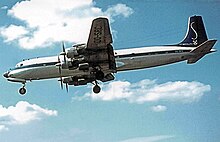
See also
[edit]References
[edit]- ^Von Schreiber, Sylvia. "Organisierte Pleite."Der Spiegel.26 November 2001. "Wenige Stunden vorher geschah noch weit Merkwürdigeres: Polizisten der Brüsseler" Aufspürungsbrigade 4 "drangen in die Privatwohnungen von vier Managern und in das Firmengebäude Sabena House am Flughafen Zaventem ein."
- ^Wragg, David W. (1973).A Dictionary of Aviation(first ed.). Osprey. p. 231.ISBN9780850451634.
- ^"Aviation Safety Network".Aviation Safety Network.Retrieved23 July2014.
- ^"World Airline Directory."Flight International.24–30 March 1993.119.
- ^Lacey, Marc (28 February 2005)."Rwandan Hotel Is Still Haunted by Horror".The New York Times.ISSN0362-4331.
- ^ab"Airbus's secret past".The Economist.12 June 2003.ISSN0013-0613.Retrieved28 December2018.
- ^Osborn, Andrew (7 November 2001)."Belgian airline goes bust with loss of 12,000 jobs".The Guardian.Retrieved17 March2021.
- ^"Sabena finally gets justice - the judges felt that the demise of Sabena was a consequence of non-compliance by Swissair contractual obligations - DBNet report January 2011 accessed 26 December 2011".Dhnet.be. 28 January 2011.Retrieved23 July2014.
- ^Gumbel, Peter (20 October 2002)."The Last Days of Sabena".Time.ISSN0040-781X.Retrieved28 December2018.
- ^"Sabena files for bankruptcy".The Guardian.7 November 2001.ISSN0261-3077.Retrieved28 December2018.
- ^"Sabena bankrupt as its last flight lands".The Irish Times.Retrieved28 December2018.
- ^"Flight schedule effective 25 March 2001 to 27 October 2001".Sabena.Archived fromthe originalon 28 October 2001.Retrieved17 March2021.
- ^"Did you ever fly by bus?".Sabena.Archived fromthe originalon 9 September 1999.Retrieved2 May2018.
- ^ab"Sabena Fleet Details and History".Planespotters.net.Retrieved24 August2021.
- ^"Sabena fleet".aerobernie.bplaced.net.Retrieved20 February2021.
- ^"Crash of a Sabca F7b/3m in Croydon: 2 killed".Bureau of Aircraft Accidents Archives.
- ^Marut, Alex (17 October 2020)."Het Enigma rond Max Wenner"[The Enigma surrounding Max Victor Wenner](PDF).taskforceliberty.be(in Flemish).Genk,Flanders, Belgium.Retrieved27 December2022.
- ^Accident description for OO-AGTat theAviation Safety Network
- ^Accident description for OO-AUAat theAviation Safety Network
- ^"17 September 1946 accident at the Aviation Safety Network".Aviation-safety.net. 17 September 1946.Retrieved23 July2014.
- ^"ASN Aircraft accident Douglas DC-4-1009 OO-CBG Gander, NF".Aviation-safety.net. 18 September 1946.Retrieved23 July2014.
- ^"December 1949 crash at the Aviation Safety Network".Aviation-safety.net. 18 December 1949.Retrieved23 July2014.
- ^"October 1953 crash at the Aviation Safety Network".Aviation-safety.net. 14 October 1953.Retrieved23 July2014.
- ^"December 1953 crash at the Aviation Safety Network".Aviation-safety.net.Retrieved23 July2014.
- ^"1954 military occurrence at the Aviation Safety Network".Aviation-safety.net.Retrieved23 July2014.
- ^"1954 crash at the Aviation Safety Network".Aviation-safety.net. 13 February 1955.Retrieved23 July2014.
- ^"Flight 548 at the Aviation Safety Network".Aviation-safety.net. 15 February 1961.Retrieved23 July2014.
- ^"1968 crash at the Aviation Safety Network".Aviation-safety.net. 13 July 1968.Retrieved23 July2014.
- ^"1970 incident at the Aviation Safety Network".Aviation-safety.net.Retrieved23 July2014.
- ^"1970 hijacking at the Aviation Safety Network".Aviation-safety.net.Retrieved23 July2014.
- ^"February 1978 incident at the Aviation Safety Network".Aviation-safety.net.Retrieved23 July2014.
- ^"April 1978 incident at the Aviation Safety Network".Aviation-safety.net.Retrieved23 July2014.
- ^"1998 incident at the Aviation Safety Network".Aviation-safety.net. 29 August 1998.Retrieved23 July2014.
- ^"2000 hijacking at the Aviation Safety Network".Aviation-safety.net. 13 October 2000.Retrieved23 July2014.
- ^Eismont, Maria."Gunfire Damages Sabena Jet in Burundi, abc News".Abcnews.go.Retrieved23 July2014.
- ^Accident description for OO-AGRat theAviation Safety Network
- ^"1943 crash at the Aviation Safety Network".Aviation-safety.net. 1 January 1943.Retrieved23 July2014.
- ^"March 1944 crash at the Aviation Safety Network".Aviation-safety.net. 25 March 1944.Retrieved23 July2014.
- ^"April 1944 accident at the Aviation Safety Network".Aviation-safety.net. 3 April 1944.Retrieved23 July2014.
- ^"1945 incident at the Aviation Safety Network".Aviation-safety.net. 14 December 1945.Retrieved23 July2014.
- ^"January 1947 crash at the Aviation Safety Network".Aviation-safety.net. 7 January 1947.Retrieved23 July2014.
- ^"December 1947 crash at the Aviation Safety Network".Aviation-safety.net. 24 December 1947.Retrieved23 July2014.
- ^"May 1948 crash at the Aviation Safety Network".Aviation-safety.net. 12 May 1948.Retrieved23 July2014.
- ^"August 1948 crash at the Aviation Safety Network".Aviation-safety.net. 31 August 1948.Retrieved23 July2014.
- ^"August 1949 crash at the Aviation Safety Network".Aviation-safety.net. 27 August 1949.Retrieved23 July2014.
- ^"1951 accident at the Aviation Safety Network".Aviation-safety.net. 24 July 1951.Retrieved23 July2014.
- ^"1952 crash at the Aviation Safety Network".Aviation-safety.net. 4 February 1952.Retrieved23 July2014.
- ^"1958 crash at the Aviation Safety Network".Aviation-safety.net. 18 May 1958.Retrieved23 July2014.
Further reading
[edit]- Wulf, Herman de (August–November 1990). "An Airline at War".Air Enthusiast(13): 72–77.ISSN0143-5450.
- Taylor, H. A. & Alting, Peter (April–July 1980). "Fokker's 'Lucky Seven'".Air Enthusiast(12): 24–38.ISSN0143-5450.
- Vanthemsche, Guy (2002).La Sabena: L'Aviation Commerciale Belge, 1923 - 2001, des Origines au Crash(1st ed.). Brussels: De Boeck Univ.ISBN9782804139810.
- Vanthemsche, Guy (2000)."The Birth of Commercial Air Transport in Belgium (1919-1923)".Revue belge de philologie et d'histoire.78(3): 913–44.doi:10.3406/rbph.2000.4471.
External links
[edit]![]() Media related toSabenaat Wikimedia Commons
Media related toSabenaat Wikimedia Commons
- Sabena(Archive)
- Sabena India(Archive)
- Sabena Technics
- Sabena Flight Academy
- Sabeniens
- Official Virtual Airline
- Gumbel, Peter. "The Last Days of Sabena."TIME.Sunday October 20, 2002.
- Documents and clippings about Sabenain the20th Century Press Archivesof theZBW
